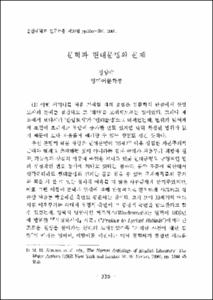텅그스텐 紛末成形體의 活性燒結에 관한 硏究
- Alternative Title
- A Study on the Activated Sintering of the Tungstem Powder Compacts
- Abstract
- 미량의 Ni을 첨가한 W의 活性燒結 擧動을 조사하였다. 活性劑 Ni은 용액 및 환원 방법으로 첨가하였으며 1100℃~1400℃온도범위에서 粉末粒度, 성형壓에 따른 수축거동을 조사하였으며 model系의 실험도 병행 하였다.
본 연구에서 얻은 결론을 다음과 같은 종합하였다.
1) 活性劑 Ni은 고상소결온도 임에도 불구하고 액상과 같이 거동하며, 이는 소결초기에 活性劑 Ni의 크기 효과 및 W-Ni界面 energy에 기인되는 것 같다.
2) 소결단계는 2단계로 나타났으며, 즉 fast, slow sintering단계로 나누어졌다. fast sintering단계는 活性劑 Ni의 액상과 유사한 거동에 기인한 系의 재배열과 活性劑 Ni상을 통한 촉진된 확산에 기인되며, slow sintering 단계는 結晶粒 成長과 기공의 粗大化 등에 기인 되었다.
3) 실험범위의 온도에서는 수축율지수, n=??을 얻을 수 있었으며, 一定한 수축에 미치는 粒度의 영향, 즉 소결 시간지수 역시 1/3에 가까운 값을 구할 수 있었다.
4) 稠密化를 위한 活性化 energy는 70kcal/mole이였으며 結晶粒 成長을 위한 活性化 energy는 28~40kcal/mole이였고 結晶粒 成長 지수는 1/2이였다.
5) 미량의 Ni을 첨가한 W의 活性燒結은 활성제 Ni상 內部 또는 W-Ni相 경계를 통한 體擴散이 소결을 지배하는 기구임을 알 수 있었다.
In the present work, the following conclusions were obtained from experimental results.
1) Nickel activator showed behaviors like liquid phase even below the nominal melting point of nickel. This phenomenon may be attributed to the tendency of reducing the total liquid-vapor interfacial area and to the size effect of nickel particles in contact with tungsten at the initial stage of sintering.
2) The sintering showed two stages; fast and slow sintering stages. It was considered that the fast sintering stage was due to the rearrangement and enhanced diffusivity of tungsten through activator layer. The later slow stage seemed due to grain growth and pore coalescence.
3) The shrinkage exponent, n=1/3 was obtained in the real system of the powder compacts at temperature range from 1100℃~ to 1400℃. From the experimental results for the relation between particle size and sintering time, the time exponent was obtained near 1/3 at the second stage of sintering for the particle size range from 0.95μm to 4.44μm.
4) The activation energy for the densification of the compacts was estimated to be about 70kcal/mole. The activation energy for grain growth at second stage of sintering was obtained 28-48kcal/mole.
5) The grain growth exponent, was obtained as 1/2, which means that grain growth rate is inversely proportional to the curvature of the grain. The microstructures of the activated sintered compact showed agglomeration of particles due to the large shrinkage during the fast sintering stage.
6) Based on the above-mentioned experimental observations, it is suggested that the major mechanism of activated sintering of tungsten is volume diffusion of tungsten through nickel activator layer and/or tungsten-nickel phase boundary.
In the present work, the following conclusions were obtained from experimental results.
1) Nickel activator showed behaviors like liquid phase even below the nominal melting point of nickel. This phenomenon may be attributed to the tendency of reducing the total liquid-vapor interfacial area and to the size effect of nickel particles in contact with tungsten at the initial stage of sintering.
2) The sintering showed two stages; fast and slow sintering stages. It was considered that the fast sintering stage was due to the rearrangement and enhanced diffusivity of tungsten through activator layer. The later slow stage seemed due to grain growth and pore coalescence.
3) The shrinkage exponent, n=1/3 was obtained in the real system of the powder compacts at temperature range from 1100℃~ to 1400℃. From the experimental results for the relation between particle size and sintering time, the time exponent was obtained near 1/3 at the second stage of sintering for the particle size range from 0.95μm to 4.44μm.
4) The activation energy for the densification of the compacts was estimated to be about 70kcal/mole. The activation energy for grain growth at second stage of sintering was obtained 28-48kcal/mole.
5) The grain growth exponent, was obtained as 1/2, which means that grain growth rate is inversely proportional to the curvature of the grain. The microstructures of the activated sintered compact showed agglomeration of particles due to the large shrinkage during the fast sintering stage.
6) Based on the above-mentioned experimental observations, it is suggested that the major mechanism of activated sintering of tungsten is volume diffusion of tungsten through nickel activator layer and/or tungsten-nickel phase boundary.
- Issued Date
- 1982
- Type
- Research Laboratory
- Alternative Author(s)
- Kwon,Y-S
- Publisher
- 연구논문집
- Language
- kor
- Rights
- 울산대학교 저작물은 저작권에 의해 보호받습니다.
- Citation Volume
- 13
- Citation Number
- 1
- Citation Start Page
- 55
- Citation End Page
- 77
- Appears in Collections:
- Research Laboratory > University of Ulsan Report
- 파일 목록
-
-
Download
 000002024149.pdf
기타 데이터 / 705.87 kB / Adobe PDF
000002024149.pdf
기타 데이터 / 705.87 kB / Adobe PDF
-
Items in Repository are protected by copyright, with all rights reserved, unless otherwise indicated.